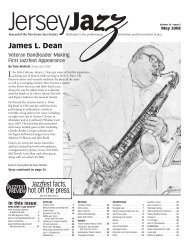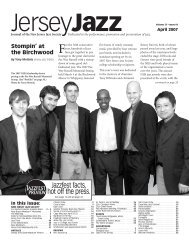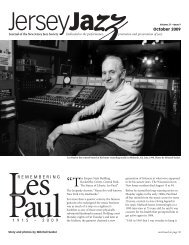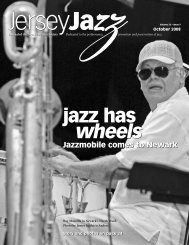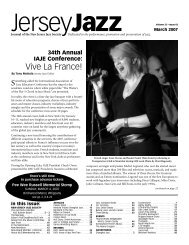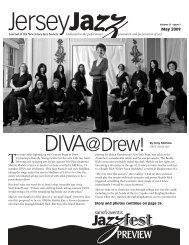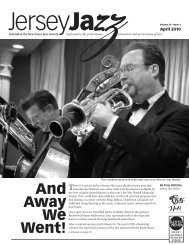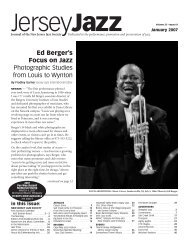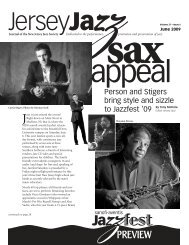He's Back! - New Jersey Jazz Society
He's Back! - New Jersey Jazz Society
He's Back! - New Jersey Jazz Society
You also want an ePaper? Increase the reach of your titles
YUMPU automatically turns print PDFs into web optimized ePapers that Google loves.
Bryant’s mother recognized Ray’s potential<br />
and sent him to a teacher when he was five<br />
years old. His formal training was classical, a<br />
foundation that he found invaluable. The<br />
pianist’s professional career began at age 12:<br />
“I would play for dances and they’d sneak<br />
me into bars. I’d get four or five bucks a<br />
night which was good money then.” At 14,<br />
Bryant became the youngest member of<br />
Local 274, the black musicians’ union in<br />
Philadelphia.<br />
Bryant’s epiphany occurred when a high<br />
school teacher took him to his first jazz<br />
concert, at the Philadelphia Academy of<br />
Music. “It opened with a local band led by a<br />
wonderful pianist named Jimmy Golden,”<br />
Bryant recalls. “Next came the Teddy Wilson<br />
Trio. Finally, this guy sat down all alone at<br />
the piano. I was absolutely astonished by<br />
what I heard. It was Art Tatum. From that<br />
moment on, I knew exactly what I wanted<br />
to do.”<br />
The young pianist’s budding jazz career did<br />
not go over well in his church: “They used<br />
to bring me up front and say, ‘Sister Bryant’s<br />
son is playing music for the devil. We hope<br />
he will change his ways!’”<br />
Bryant became part of the vibrant Philadelphia<br />
jazz scene of the late 1940s and early<br />
1950s: “I hung out with guys like Philly Joe<br />
[Jones], Benny Golson, and the Heath<br />
brothers. We used to have little jam sessions<br />
at the home of [trumpeter] Johnny Coles.”<br />
He also recalls an early encounter with John<br />
Coltrane: “He joined a local band I was<br />
working with for one engagement. He was<br />
playing alto then and played it beautifully.<br />
Although some things he did were reminiscent<br />
of Charlie Parker, you could already<br />
hear his own thing.”<br />
In 1948, guitarist Tiny Grimes came<br />
through town and took the 17-year-old<br />
Bryant on his first tour. After a two-year<br />
stint with Grimes, the pianist returned to<br />
February 2009<br />
<strong>Jersey</strong>Articles<strong>Jazz</strong><br />
Finally, this guy sat down all alone<br />
at the piano. I was absolutely<br />
astonished by what I heard. It was<br />
Art Tatum. From that moment on,<br />
I knew exactly what I wanted to do.<br />
Philadelphia.<br />
Bryant’s trio<br />
backed visiting<br />
jazz stars at<br />
the local clubs<br />
like the Blue<br />
Note, where he<br />
worked with<br />
such luminaries<br />
as Roy<br />
Eldridge, Stan<br />
Getz, Ben Webster, Lester Young, Miles<br />
Davis, Charlie Parker, and Sonny Rollins.<br />
Davis and Rollins were so impressed with<br />
the young Philadelphian that each brought<br />
him to <strong>New</strong> York to record in 1955. The<br />
Davis session (Miles Davis and Milt Jackson,<br />
OJC) even included a Bryant composition,<br />
“Blues Changes.” “Miles definitely knew<br />
what he wanted,” says Bryant. “He told me<br />
to play my chords a little shorter—not to let<br />
them ring so much.”<br />
Of the Rollins date (Worktime, OJC), Bryant<br />
laughs and says, “My biggest memory from<br />
that session was playing fast like on ‘There’s<br />
No Business Like Show Business,’ which we<br />
did with the verse!” Also in 1955, Bryant was<br />
paired with Betty Carter on Meet Betty<br />
Carter and Ray Bryant (Columbia Legacy),<br />
an important “debut” album for both artists.<br />
In 1959, after a stint as Carmen McRae’s<br />
accompanist, Bryant decided to make the<br />
move to <strong>New</strong> York where he continued his<br />
eclectic musical education: “I spent my<br />
afternoons at the Metropole with guys like<br />
Roy Eldridge, Coleman Hawkins, and<br />
Charlie Shavers. Then at night I’d go down<br />
to the Five Spot and play with the younger<br />
guys like Benny Golson and Curtis Fuller.”<br />
The pianist felt completely at home with<br />
both groups, explaining, “A C-chord is a Cchord<br />
no matter where you find it. I never<br />
made a conscious effort to play differently<br />
with anyone,” he adds. Indeed, as the<br />
recordings clearly indicate, Bryant has<br />
always managed to fit into any context while<br />
remaining himself, so timeless is his style.<br />
Two of the veterans with whom Bryant<br />
forged close relationships were trumpeter<br />
Charlie Shavers and drummer Jo Jones.<br />
“Rehearsing with Charlie was a lot of fun,”<br />
recalls the pianist. “We’d arrive at his house<br />
around noon and he’d always have something<br />
on the stove for us. So we’d eat and<br />
talk and by three or four we might get<br />
around to actually rehearsing two or<br />
three tunes!”<br />
In 1959, Jo Jones approached Bryant and his<br />
brother, Tommy, about forming a trio. Bryant<br />
learned some valuable lessons from the<br />
venerable drummer: “He could sense when<br />
you weren’t relaxed and would say, ‘Take your<br />
time and breathe!’ He also taught me about<br />
pacing a set. I still use his format today.”<br />
After leaving Jones, Bryant formed his own<br />
trio, and in 1960 John Hammond, the<br />
legendary talent scout and indefatigable jazz<br />
booster, signed him to Columbia. “We had<br />
more than just a producer-artist relationship,”<br />
says Bryant. “I felt like I was almost a<br />
member of his family.” Bryant’s first album<br />
for the label contained his huge hit, “Little<br />
Susie.” “It was born during my days with Jo<br />
Jones,” he recalls. “We had no theme song,<br />
so he said, ‘Just play some blues,’ and I<br />
ended up with this little theme which<br />
evolved into ‘Little Susie’.”<br />
Soon afterward, Hammond took Bryant to<br />
Baltimore where a new dance, the Madison,<br />
was beginning to take off. The producer<br />
asked the pianist if he could come up with<br />
some appropriate music. “Years before in<br />
Philadelphia I’d written a little R&B thing<br />
which Percy Heath suggested I call ‘Shuckin’<br />
and Jivin’. When I saw the dance I<br />
remembered it.” The piece was a perfect fit<br />
and, as “Madison Time,” became another hit<br />
for Bryant. In 1988, it enjoyed a second life<br />
in the John Waters film Hairspray. Through<br />
Hammond, in 1967 Bryant played at the<br />
30th anniversary From Spirituals to Swing<br />
concert where his impromptu duet with<br />
ailing boogie-woogie legend Pete Johnson<br />
was an emotional highlight.<br />
In 1963, Bryant recorded the first of four<br />
albums for Sue, a soul label known for its<br />
work with Ike and Tina Turner. In 1966 he<br />
moved on to Cadet which recorded him in a<br />
variety of contexts, from trio to orchestral.<br />
The range of material was also varied, mixing<br />
jazz standards with pop hits of the day.<br />
For example, Take a Bryant Step is undoubtedly<br />
the only album to contain both<br />
“Ode to Billie Joe” and Ornette Coleman’s<br />
“Ramblin’.” The pianist also supplied several<br />
imaginative charts for horns and strings on<br />
that and other Cadet albums. “When I was<br />
12 or 13, I wrote a thing called ‘Railroad<br />
Jump’ for a whole orchestra,” he recalls. “I<br />
never actually studied arranging. I learned<br />
continued on page 26<br />
_________________________________ 25



